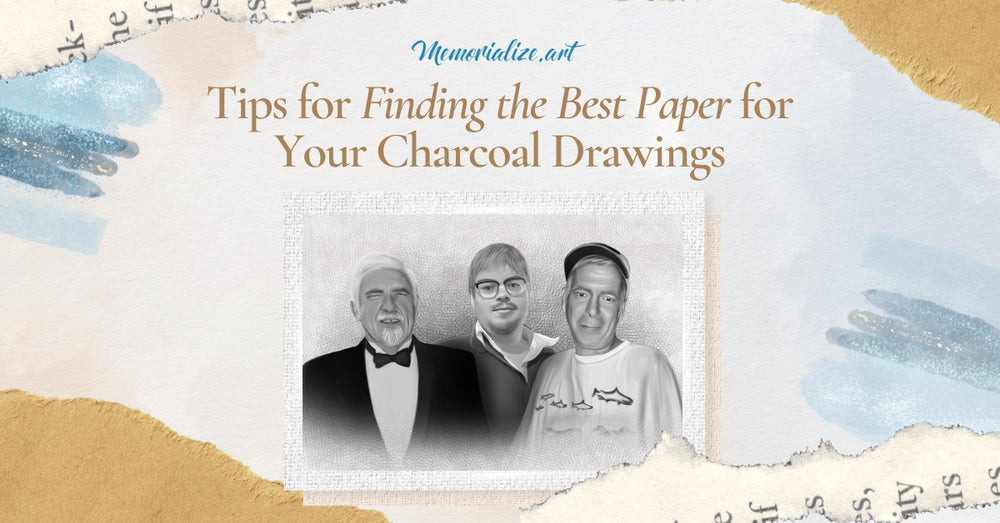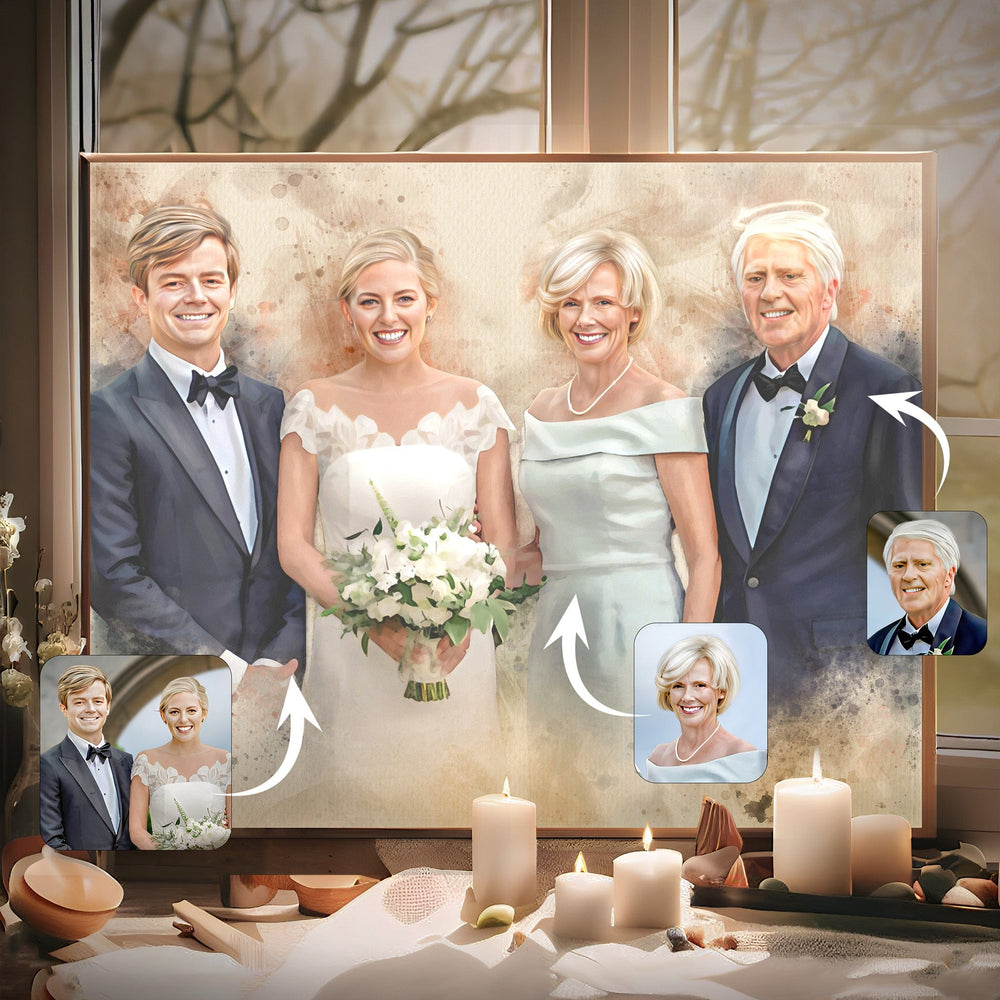Finding The Best Paper for Your Charcoal Drawings


Photo by Dusan Kipic on Unsplash
Choosing a suitable paper for charcoal drawing is a very important choice that can have a big effect on how your coal drawing turns out in the end. How the charcoal reacts with the surface of the ideal paper depends a lot on the thickness, weight, and quality of the paper. This affects the depth, details, and general look of your charcoal sketch. Plus, Picking the best drawing paper for graphite and charcoal will ensure that your artwork will showcase your drawing skills.
Why Select An Appropriate Paper Type for Your Charcoal Drawing?
Charcoal drawings are a popular medium for celebrating family milestones. You can use this medium for coal paintings, such as graduation, wedding, or memorial portraits. That’s why it’s important to find the right tools for your artwork, such as the right drawing paper. The charcoal drawing paper you will use can significantly impact the overall quality, durability, and visual appeal of your charcoal sketches. Charcoal is a versatile medium known for its soft edges, smudging, and blending properties, as well as its ability to create rich, dark tones. The right paper will provide the necessary tooth or charcoal paper texture to hold the soft charcoal particles, allowing for precise control and manipulation of the medium. It should also withstand multiple layers of charcoal, erasing, and blending without tearing, smudging excessively, or losing its integrity.
Types of Paper for Charcoal

Order Your Christmas Charcoal Drawing Here
While it's mostly a question of taste when deciding the type of paper to use for a charcoal drawing, it's still important to be familiar with the many options. Here are a few examples of the various paper kinds available to you:
Charcoal Paper

Photo by Unsplash from Unsplash
The charcoal paper stands as the optimal choice for artists due to its tailored characteristics that enhance the unique qualities of this dusty medium. It is specifically designed to accommodate the requirements of charcoal drawing.
This type of paper is made of cotton fiber and features a rough and textured surface that offers a superior texture, providing the necessary grip for charcoal particles, even if it is enhanced with soft pastels. As a result, artists can effortlessly apply and manipulate charcoal, creating a wide range of expressive marks, textures, and shading.
Smooth Papers

Photo by Leeloo theFirst from Pexels
While charcoal drawings are commonly associated with textured papers, smooth drawing paper, like charcoal on watercolor paper, can also be advantageous for certain artistic intents and techniques. Its smooth surface offers a different aesthetic and allows for precise, detailed rendering in charcoal drawings, even without the use of a workable fixative.
Acid-Free Paper

Photo by Dan Christian Paduret from Unsplash
Because it is delicate, charcoal can easily deteriorate over time if not treated with care. Acid on paper causes yellowing, fading, or degradation of the artwork. On the other hand, acid-free papers are made with a neutral pH level throughout production to prevent these from happening to the coal drawing. This is ideal if you want to create a keepsake, such as a christmas charcoal drawing of your family.
Pastel Paper

Photo by Kelly Sikkema from Unsplash
The rough or toothed surface of the pastel paper for charcoal drawing creates a captivating texture. It adds depth, dimension, and visual interest to the artwork. It enables artists to effortlessly create rich, expressive strokes, subtle gradients, and gestural techniques. Moreover, pastel papers come in a variety of colors, including shades of gray, tan, and brown, which can add an additional layer of depth and atmosphere to your cool charcoal drawings.
Colored Paper

Photo by Engin Akyurt from Unsplash
When combined with the deep blacks and rich tonal values of charcoal, black charcoal paper can create a visually stunning effect, particularly in drawings focused on high contrast and dramatic lighting.
While often associated with black or toned papers, white charcoal drawings can create a striking visual impact when paired with charcoal. The white background allows for a strong contrast between the dark charcoal marks and the paper, resulting in a high level of clarity and crispness in the drawing.
The cool tone of the blue paper creates a distinct atmosphere, evoking a sense of tranquility, depth, and even mystery in the artwork. The charcoal marks stand out prominently against the blue background, creating a dynamic interplay between light and shadow.
Tips for Selecting the Right Type of Paper

Order Your Baby Charcoal Drawing Here
When selecting paper for your charcoal drawing, remember to consider if you are planning to engage in charcoal on watercolor paper or explore different types of charcoal for drawing. This will influence your choice significantly, as each type of paper responds differently to various charcoal drawing tools and techniques. Here are some tips on how to select the right type of paper:
Consider The Surface Textures
The lines, precise shading, and overall aesthetic attractiveness of your drawing are all affected by the toothy surface since it dictates how the charcoal sticks to the paper and interacts with the surface. A rougher paper, like fine-tooth sanded papers, provides more grip for the charcoal particles, allowing for better control and a greater range of expressive marks. This is especially beneficial for creating cool charcoal drawings and charcoal techniques that require texture and depth.
On the other hand, a smooth surface texture allows for finer details, precise lines, and smoother blending. It is ideal for achieving a polished and refined look in your charcoal drawings, like in a baby charcoal drawing or a family portrait. Artists exploring easy charcoal drawing techniques may find smooth paper accommodating to their learning curve.
Evaluate The Weight and Thickness
Heavyweight papers, such as 100 lbs or higher, offer more substantial support and can withstand multiple layers of charcoal, erasing, and blending without buckling or tearing. This is crucial for artists working with charcoal on canvas, as it requires a more robust backing. A lighter sheet of paper, like pencil drawing paper, may be more suitable for preliminary sketches or studies, especially when considering beginner charcoal drawing ideas.
Moreover, thicker papers tend to have a sturdier feel and can handle heavier applications of charcoal, essential for those experimenting with white charcoal drawings or charcoal sketching. Meanwhile, thinner papers offer more translucency and are often preferred for techniques like tracing or transferring finished drawings, a common practice in charcoal drawing materials usage.
Incorporate Mixed Media Techniques
Don't limit yourself to just charcoal; consider integrating other mediums in your charcoal drawing. For instance, applying charcoal on watercolor paper allows for the combination of watercolor and charcoal, which can yield beautiful, ethereal effects. This method is excellent for artists who enjoy blending charcoal techniques with other mediums, creating multifaceted pieces with rich textures and depth.
Techniques for Charcoal Drawing on Paper

Incorporating techniques into your charcoal drawing practice can elevate your art. Whether you're exploring types of charcoal for drawing or trying out different charcoal drawing materials, these methods can help in achieving a range of artistic effects.
Blending
Blending is a key technique in easy charcoal drawing, where artists use charcoal pencils to blend or smooth the lines and transitions, creating a harmonious flow of tones and values on rough paper. This method is especially effective for beginner charcoal drawing ideas, as it allows for forgiving and adaptable manipulation of the medium. Artists often use their fingers, blending sticks, soft cloths, or even specialized tools designed specifically for blending and shading with charcoal. This technique is crucial in mastering charcoal techniques and charcoal sketching.
Stippling
Stippling is a distinctive approach that adds texture and pattern to coal painting. It involves creating numerous small, distinct dots or marks with the tip of a charcoal stick or a sharp charcoal pencil. This method is particularly effective on charcoal on paper, where the light, controlled application of dots can create varying effects. The variability in dot size and spacing allows artists to achieve diverse visual effects, making stippling an excellent technique for cool charcoal drawings and white charcoal drawings.
Layering
Layering is essential for creating intricate features, subtle shifts in value, and a sense of depth in charcoal drawings. This technique is integral to charcoal drawing materials and the process of charcoal on canvas, where building up layers can add complexity and richness to the subject matter.
Final Thoughts
The quality of the paper you use will have a significant impact on the output of your charcoal drawings. You can discover the perfect paper for drawing with charcoal by tailoring the surface to your preferences in terms of texture, weight, and color. Remember to use high-quality paper, experiment with various techniques, and consider the specific requirements of your charcoal art.
Make Your Photos Extra Special By Getting a Charcoal Portrait from Memorialize Art
A charcoal drawing is a piece of art that will never go out of style because it shows the subject's soul and personality. Each charcoal picture from Memorialize Art is made by hand with care but still comes at an affordable price. The attention to detail and the dedication to craftsmanship ensure that every piece is a unique and exquisite work of art.










